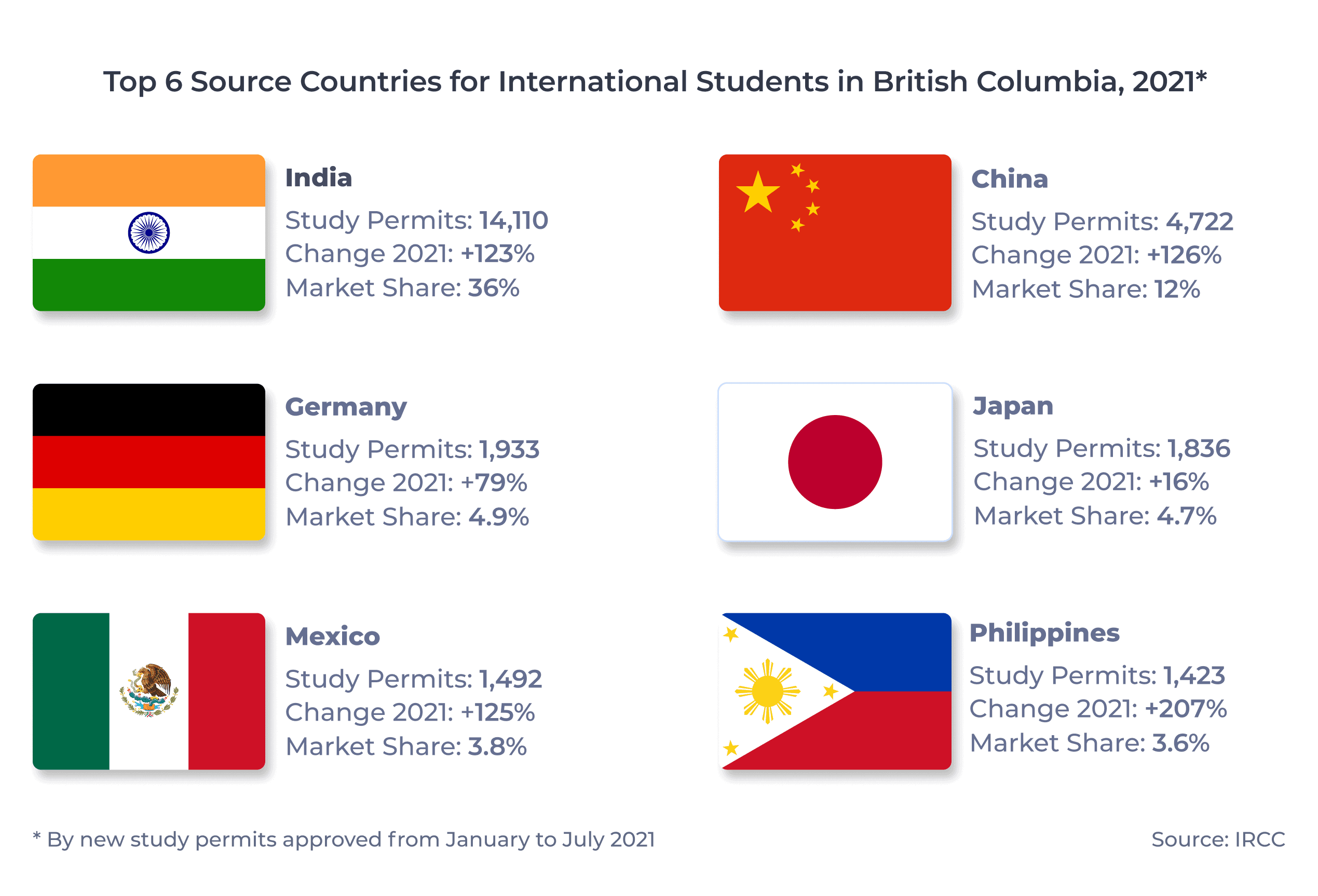British Columbia (BC) has long been a leader in international education in Canada, helped in recruiting by its proximity to Asia and the work of the British Columbia Council for International Education (BCCIE), a government Crown agency that supports and helps coordinate international education in the province. But BC’s student inflows stagnated in 2019, and industry stakeholders raised concerns. Had BC—or at least the Vancouver metro area—effectively reached its international student capacity?
The COVID-19 pandemic pushed these concerns to the back burner in 2020. But now, as BC’s international student population has risen again post-pandemic, observers are again asking these sorts of questions.
Key Insights at a Glance
- The number of new study permits approved for BC students fell by 54% year-over-year in 2020. However, this was better than the average for the rest of Canada (-57%).1
- BC saw a strong recovery over the first seven months of 2021,2 with new study permits approved rising by 67% over full-year 2020.
- In 2020, 35% of all new study permits approved in Canada for K-12 students were for BC schools. This was the largest market share for the province since 2015.
- Germany, Mexico, and the Philippines posted strong study permit numbers from January to July 2021 and are source countries to watch moving forward.
How have international student inflows shifted in BC since the pandemic? Where are these students coming from, and what are they studying? Join me in the fifth and final installment of our Canadian Provincial Study Permit Trends series.3
Canadian Study Permits Approved – British Columbia
As Canada’s most mature international student market, British Columbia saw diminishing year-over-year student visa4 gains pre-pandemic. The chart below shows the trend:
The number of students approved to study in BC grew by 22% in 2017. But 2018 saw just 6% growth, and in 2019, this trend flattened out completely. With the onset of the pandemic, the number of new study permits approved tumbled by 54%. But the first seven months of 2021 brought a significant rebound, with numbers up 67% compared to full-year 2020.
British Columbia vs. the Rest of Canada
The table below compares British Columbia to the rest of Canada for new study permits approved since 2019:
| 2019 | 2020 | 2021 (Jan–Jul) | ||
|---|---|---|---|---|
| British Columbia | Total | 50,533 | 23,460 | 39,072 |
| YOY Change | +0.2% | -54% | +67% | |
| Rest of Canada | Total | 205,610 | 88,900 | 159,653 |
| YOY Change | +16% | -57% | +80% |
Source: IRCC
Pre-COVID, BC’s growth lagged well behind the rest of Canada’s, where a massive increase in international enrollment in the Ontario college sector fuelled year-over-year growth of 16% in 2019. But BC actually outperformed the rest of Canada by a few percentage points in 2020. New study permits approved fell by 57% across the remaining nine provinces, versus 54% for BC.
While BC didn’t quite see the same rebound as the rest of Canada over the first seven months of 2021, the province was on track to blow past its previous record of 50,533 new study permits approved for the year.
Let’s dig a little deeper to see what program levels this influx of students is pursuing.
Study Permits Approved by Study Level – British Columbia
The chart below maps new study permit approvals by study level in BC over the past five years:
Led by the University of British Columbia (UBC), which saw almost 7,000 international students approved to study between January and July 2021, BC’s university sector came nearly all the way back from the pandemic dip in a little more than half a year. The college sector has seen a similar bounce back, but had further to recover following a larger drop in 2020 (60% vs. 51%).
BC’s robust K-12 sector saw the smallest drop in 2020, at just 43%. This mirrored a trend we saw across Canada, where K-12 approval numbers fell less than every other study level except university. We suspect this was driven by mature students with families continuing to go abroad during the pandemic at a higher rate than younger, childless students. It’s worth noting, though, that BC’s secondary sector fared as well as its primary sector This suggests that many parents continued to send their children abroad to BC during the pandemic, perhaps because of its long-established reputation as a homestay destination.
Study Level Comparison: British Columbia vs. the Rest of Canada
Given its mature offerings across the market, British Columbia’s distribution of new study permit approvals by study level is fairly balanced. You can select Rest of Canada or Rest of Canada (No Ontario) in the chart below to see the comparison:
Whether or not you include Ontario—where many large-capacity colleges skew the data significantly—BC’s K-12 sector and language sector are well above national averages.5 In particular, the K-12 sector in BC accounted for nearly 1 in 4 new study permits approved in the province over the first seven months of 2021. In the pandemic-impacted year of 2020, BC accounted for more than a third of international K-12 students approved to study in Canada for the first time since 2016. This trend held through the first seven months of 2021, as well.
Turning to higher ed, 39% of study permits approved in BC were for university studies—up from 32% in 2019—while 27% were for college. These numbers place BC squarely in the middle of the rest-of-Canada averages with and without Ontario. Simon Fraser University accounted for almost 2,000 new study permits approved between January and July 2021, second only to UBC among universities. On the college side, Langara College was the top destination, with nearly 3,000 approvals.
Top Source Countries for British Columbia Students
Turning to the top source countries for international students at BC institutions, we see a few surprises:
India and China led the way, together accounting for 48% of all study permits approved for BC institutions in the first seven months of 2021. Though significant, this is well below the average for the rest of Canada, at 61%. In particular, BC is significantly less dependent on the Indian market than the rest of Canada. Just 36% of study permit approvals for BC institutions in the first seven months of 2021 were for Indian nationals, versus 51% for the rest of the country.
While Indian students are an important part of the international student population in BC, the province is focused on bringing in students from a wide variety of countries. Says Dr. Randall Martin, Executive Director of BCCIE, “One of the fundamental planks of internationalization is diversification, having truly international campuses where you can learn from and engage with people from many different cultures.”
Behind India and China, Germany was a surprising third, with nearly 2,000 study permits approved. Mexico and the Philippines also climbed into the top six.
Let’s look at the newcomers to the top six in detail.
Germany was the rare source country for which the number of new study permit approvals for BC institutions actually increased in 2020, despite the pandemic.
Then, over the first seven months of 2021, that 2020 total nearly doubled:
This student population is almost entirely secondary students. In fact, more than 1,600 of the almost 2,000 German nationals approved to study in BC between January and July 2021 were slated to attend high school. Nearly 200 more were undergraduate university students.
Study abroad programs are extremely popular in Germany. This surge in German secondary numbers likely reflects a shift among German students in these programs from the UK to Canada post-Brexit.6
The number of Mexican students approved to study in BC peaked at just over 2,000 in 2018. In 2019, that number fell below 1,800; it fell below 700 in 2020 with the pandemic. The good news? Things turned around in a hurry in 2021. More than twice as many Mexican nationals were approved to study in BC over the first seven months of 2021 as in all of 2020.
Of these, 26% were university students. This was a huge shift from pre-pandemic trends, when this percentage hovered between 9% and 13%. Part of this market share came at the expense of BC colleges, which accounted for just 23% of approvals for Mexican students from January to July 2021. This was down from 36% in 2020 and 29% over the previous three years.
The quick rebound in the Mexican market was no surprise to Dr. Martin at BCCIE. “A lot of the growth in the North American international student market is poised to come from Latin America,” he says, in part due to the relative proximity between source and destination countries and global trends toward more regional mobility.
We saw explosive growth in the number of Filipino students approved for study permits across Canada in 2021. With nearly 7,000 students approved for a study permit between January and July, the Philippines was the third-largest supplier of students to Canada over that period. As recently as 2019, it was ninth.
Turning to BC, the Philippines was one of just three markets7 in the top 10 to send more students to the province in the first seven months of 2021 than in full-year 2019. It is primarily a college market, with 55% of students approved at that level from January to July 2021. Another 14% of Filipino students were approved for primary school, reflecting the large number of Filipino parents who come to study in Canada with their families.
We covered many of these trends and more last year in ApplyInsights: Study Permit Trends in Canada – Philippines.
Key Takeaways
British Columbia’s strong international education foundation helped the province weather the storm of the COVID-19 pandemic in 2020 and has led to an encouraging rebound in 2021. But what about our earlier question? Has BC, or at least the Vancouver metro area, effectively reached its international student capacity?
We don’t think so. Rather, we think the pandemic has underscored how well positioned BC is to withstand industry shifts as Canada’s most mature destination market.
BC’s proximity to East Asia and its well-established East Asian communities are permanent pull factors that make the province particularly attractive to students from that region. We expect student inflows from Hong Kong will continue to increase, aided by the government of Canada’s immigration measures to support Hong Kong residents. Look for the South Korean market, which saw upwards of 4,000 study permit approvals for BC institutions as recently as 2017, to begin to rebound in 2022, as well.
We asked Dr. Martin for his thoughts on what BC institutions can do to continue their recovery from the pandemic and ensure a stable future. Here’s what he said:
- Many of the technology-aided shifts we’ve seen during the pandemic, from virtual recruitment fairs and Zoom meetings to digital content delivery, are here to stay in some form and to a high degree. Schools that have been slow to embrace these strategies risk putting themselves at a permanent disadvantage.
- Focus on partnerships and growing student inflows from Latin America and Southeast Asia, where Canada (and BC) has cost and geographical advantages.
- Don’t be afraid to explore innovative solutions in student housing, such as in new off-campus private and public-private partnerships.
- Explore connections with local industry to find co-op and post-graduation career opportunities for international students and highlight these connections in marketing materials.
Published: February 1, 2022
Subscribe to ApplyInsights
Sign up for the latest insights on international education.

About the ApplyInsights Team
FOOTNOTES:
1. All data courtesy of Immigration, Refugees and Citizenship Canada (IRCC), except where noted.
2. More recent data not yet available.
3. Previously, we covered Ontario, Quebec, the Prairies, and Atlantic Canada.
4. The terms student visa and study permit are generally used interchangeably for Canadian international students. Rather than student visas, Canada provides accepted international students with study permits, which allow those students to enroll in classes at Canadian institutions. When a student is accepted for a study permit, they are also usually provided with a visitor visa, which allows that student to enter Canada for their studies.
5. Note that many language students who study in Canada for less than six months are not required to obtain a study permit and so are not captured in this data.
6. Italian secondary student numbers have followed a similar trajectory.



